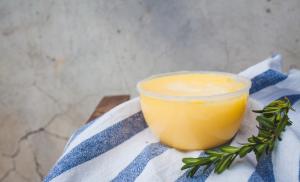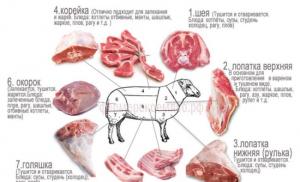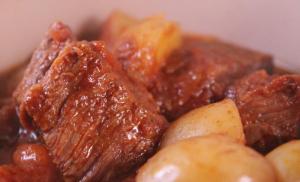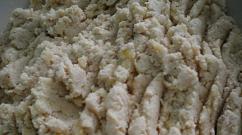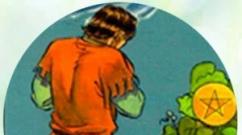Puzzle games Japanese crosswords. Japanese crossword puzzles to solve for free
Japanese crossword(otherwise known as nonogram) is a puzzle in which, unlike ordinary crosswords, not words, but images are encrypted.
Similar nonograms appeared in Japan at the end of the 20th century and, despite their unusual appearance and seemingly frightening difficulty, they were able to gain popularity among puzzle lovers all over the world, including in Russia.
Correctly solving a Japanese crossword means restoring an image encrypted using numbers. An encrypted image can be any object: transport, animal, person, any symbols. A professionally designed crossword puzzle should have a single logical solution without any options.
Japanese crosswords are divided into two types - black and white and color. In black and white crosswords, the image contains only two corresponding colors: black and white, and the image itself can be either black on a white background or white on black. In color crosswords, an image is created using several colors.
Learning to solve Japanese crosswords is not difficult. To do this, it is enough to master the algorithm for solving a nonogram for a sufficiently long time. simple example to understand the whole essence of this puzzle, and then you can safely choose crossword puzzles with complex images.
Since the rules for solving color and black-and-white crosswords are somewhat different, let us first consider the features of composing and solving black-and-white crosswords.
First, let's look at the diagram of such a crossword puzzle.
example of a solved Japanese crossword puzzle
As you can see, the field of the Japanese crossword puzzle is lined with horizontal and vertical lines of different thicknesses. The thickest lines separate the picture field from the numbers. Thinner lines divide the field into groups of 5 cells (both horizontally and vertically) solely for ease of counting.
The image itself in the Japanese crossword puzzle is formed by painting individual cells black. An unpainted cell is considered white. In the process of solving it is necessary to reconstruct the picture using the available numbers.
Thus, the numbers in the Japanese crossword grid on the left and above mean the number of shaded cells in a row, without gaps, horizontally and vertically, respectively. Each individual number represents a different group. For example, a set of numbers 7, 1 and 2 in a Japanese crossword puzzle grid means that there are three groups in this row: the first is of seven, the second is of one, and the third is of two black cells. Moreover, between the groups there must be at least one unshaded cell. Empty cells can also be at the edges of the rows. When solving a Japanese crossword puzzle, you need to determine the placement of these groups of cells.
It is recommended to start solving the puzzle by finding horizontal lines or vertical columns, where you can draw some conclusion about which cells are shaded and which are not shaded. These logical conclusions can be displayed with special marks that will help you get new clues for solving the crossword puzzle.
EXAMPLE SOLUTION TO A JAPANESE CROSSWORD:
Let's look at a simple example consisting of 9 rows and 9 columns.
picture 1
We will denote shaded cells with a black square, and an empty field with a blue cross. For convenience, we will cross out the numbers after determining their location.
figure 2
First, let's see if there are any lines in the crossword puzzle that should be completely filled in. It turns out that there is - in our case it is the number 9 in the fifth row and fifth column, which the arrows point to. Since the width of the crossword puzzle is exactly 9 cells, this means that all the cells in this line must be filled in. At the same time, we cross out both numbers 9 so that they no longer distract us.
figure 3
Please note that as a result of the first step, we automatically found a solution for the first row, as well as for the first and ninth columns, where in all cases only one cell is shaded. This means that all other cells in these rows will be empty. Cross out all three numbers used and mark the empty cells.
figure 4
Again we carefully study the result of previous actions. It becomes clear that the fourth line again defines the entire group of seven consecutive cells that can be safely shaded.
Figure 5
You should always pay attention to the largest of the proposed numbers, which more easily provide a clue for further solving the puzzle. In our case, these are two sixes in the second and eighth column. Since the position of a group of six cells in these combinations will be ambiguous, let’s try to reason logically. At the same time, we will get acquainted with one of the basic principles of solving Japanese crossword puzzles. Let's remember a simple rule. If there is only one number next to a row or column, and it is more than half the length, then you can paint over several cells in the middle. In our case, these are the central four cells. No matter how you place a group of six cells in eight cells, the four central ones will definitely be shaded (i.e. 8-6=2, which means the number of “unknown” cells above and below). Since we have not yet made a final decision on these columns, we do not cross out the numbers themselves yet, but circle them in red. We'll return here later when we get a new lead.
Figure 6
And again luck smiled on us. In the sixth and seventh lines, the solution was identified automatically as a result of previous manipulations. Cross out unnecessary numbers and mark empty cells.
figure 7
Since the crossword puzzle is quite simple, several options for its further solution are already being looked at. They are obvious. You can go either way. For example, again pay attention to the largest remaining numbers. Let's leave the five in the third line alone for now, because... It's easier to cross out the number 4 in the obvious sixth column first. Don't forget to mark empty cells.
figure 8
Now there is no doubt about the location of the group of three cells in the adjacent column to the right.
Japanese crosswords are picture logic puzzles, also sometimes called Griddler, Nonogram, Pic-A-Pix, Picross or Color in numbers, as well as several other less common names.Solving the riddle correctly reveals a hidden piece of art that you can use to help confirm you are on the site website as you decide.
How to solve Japanese crossword puzzle?
This type of puzzle consists of a rectangular grid with one or more clues for each row and column of the puzzle. The key for each line is on the left side of the puzzle; the keys for the columns are at the top. Each set of clues tells you about the shady public gardens in its own row or column. These key sets are all you need to solve all the puzzles. For example, solving the puzzle on the left shows how the keys work. Rows or columns with only one clue number, such as for example "1" or "5" in the puzzle on the left side, show that there are that many consecutive shaded squares somewhere in that row/column. Other squares in the row/column must be empty.When there are multiple numbers in a key, there are several groups of consecutive shaded squares with at least one unshaded square between each set. For example, "2 1" means that there are 2 consecutive shaded squares, break one or more empty squares, then 1 more shaded square. Any other squares in the row/column are unshaded. The order of the numbers tells you the order of the shaded sets.
Every Japanese crossword has only one possible solution, and you can reach that solution by intelligent inference. Fortune telling is never required. It's not necessary to use a picture to help you solve the puzzle, although it can certainly give you a good hint that you might be making a mistake if it doesn't seem to come out right!
Japanese crosswords appear in a wide range of sizes and difficulties.
Let's look at an example of how to correctly solve Japanese crosswords.
What should be done?
Note- In nonogram, two chains of black squares are separated by an X.
Why these numbers?
Each number indicates the number of black squares in each row/column chain.
What is not allowed?
![]()
Where to begin?
Think logically. Look at this example:
![]()
If the chain started at the beginning of the line, it will end in the third field:
![]()
If the line ends at the end of the line, starting from the third window:
![]()
In both cases the third block must be black:
![]()
How to solve Japanese Crossword (Hanjie, Nonogram)
Hanjie is an elegant and rewarding puzzle game where correct solution The riddles will reveal the hidden picture.Puzzle Japanese Crossword consists of a rectangular grid with one or more clues for each row and column of the puzzle. On the puzzle they are shown on the left and at the top of the puzzle respectively. Each set of clues tells you the number of shaded squares that are in that row or column.
A row or column with a single number clue, such as "4", means that there are 4 consecutive shaded squares and that the rest of the row/column is empty. If there are multiple numbers, such as "2 3 1", this tells you there are several sets of consecutive shaded squares. "2 3 1" means, for example, that there are 2 consecutive shaded squares, a gap of one or more empty squares, 3 consecutive shaded squares, a gap of one or more empty squares, and then 1 shaded square. In other words, the number order tells you the order in which the different groups of consecutive shaded squares are found.

Initially all squares are dirty Orange color. This indicates that the squares are in an "unknown" state - they are not shaded or transparent. You can shade squares by clicking on them, or drag across the puzzle to shade multiple squares easily. Right-click or ALT-click to mark the squares as blank.
Two columns and one row with the "10" clue can be shaded at once because there is no choice about where those 10 shaded squares go - there are only 10 squares in each row and column.

Now let's look at the line with the hint "3 2 3". This is the only possible solution because there must be a gap of at least one square between different sets of successive shaded squares. So we can label this and identify the empty squares. It's useful to keep track of empty squares because it gives you useful information about where the shaded squares can fit when cross-referencing horizontal and vertical keys. However, they do not need to be marked on the puzzle to be considered a correctly solved puzzle.
It is also useful to keep track of which clues or parts of the clue you have solved. On puzzlemix you can shade the clues if you like (or mark them if you want) the same way you can mark any of the squares.

Exist various ways moving forward from here, but let's look at the fourth and seventh columns, which both have the key "3 1 2". By counting squares, you can determine where some, but not all, of the shaded squares should be. "3" consecutive squares must go in the top half of the puzzle so that we can mark two of them. At the bottom of the puzzle we know where one of the squares from the “2” part of the clue should be. We can also mark the squares around the "1" in the center of the column:

This is useful because we can now see that we have completely solved the second, third and ninth lines, and can then check in the empty boxes to indicate this:

We can also mark the many empty squares in most columns based on the clues we have:

On this moment it's a simple case of working through the remaining unused clues to solve the puzzle. Final result as follows:

Japanese crosswords or Hanjie
Here's something new, well, for this site anyway: puzzles Hanjie, were formerly known under the name "Tsunami".This type of crossword puzzle is not related to Sudoku. This is a logic puzzle with its own rules, which are quite simple:
1.
You start with a blank grid and you have to draw it so that the number sequences on the left and top are satisfied.
2.
If there is only one number for a row/column, it means that there is only one "stroke" of black cells in that row/column. Of course, the number indicates how many black cells are in that stroke.
3.
If there are more numbers, they will tell you how many strokes of black cells there are. Two patches of black cells MUST be separated by at least one white cell.
4.
Each row or column can begin and end with any number of white cells, including zero.
The tricky part is that you don't know how many white cells separate the two sections of black cells. However, each Japanese crossword puzzle can only be solved using deductive logic! You have to do a little math and add a few numbers, that's where the difficulty ends.
When you complete a puzzle, you get a picture of something. This is usually a portrait of a person or a silhouette of an animal or some kind of sign. That's why these riddles are so attractive.
Hanjie Puzzles are becoming quite popular these days. Okay, after all this talk, here are our samples Japanese crosswords online (Hanjie) for you!
Real Japanese crosswords must satisfy the following rules:
- The crossword puzzle has a single logical solution;
- There are no zeros in the information fields;
- The crossword grid has only a horizontal and vertical number of cells that are a multiple of five (for example: 5, 10, 15, 20, 25, ..);
- The image is not symmetrical and contains an easily readable image.
Solving black and white crossword puzzles
How to solve Japanese crossword puzzles?
Two simple rules To successfully solve a Japanese crossword:
- The order of numbers is: bottom to top and left to right. That is, if there is a number 3 in a column, and 1 above it, then this means that you need to color (somewhere) 3 cells below, and 1 cell above them in this column. The same applies to strings.
- Between the shaded cells there must be at least one unshaded cell.
At the first stage, we look for those rows and columns in which the number of cells to be painted will be maximum. The next step will be to identify those rows and columns where the number of cells to be painted will be more than half of the entire column or row.
In these rows or columns we will find those cells that will be painted in any case, regardless of which side the field to be painted begins on. After this, you can already identify those cells that will definitely not be painted over. They must be marked with some kind of icon, for example, a cross or a dot. Then logical reasoning comes into play, with the help of which we bring the solution to the crossword puzzle to the end. In the process of solving a crossword puzzle, the described moves can be repeated several times.
As soon as any cells have been colored, the number that belongs to these cells must be crossed out so as not to get confused (especially on huge crossword puzzles).
An example of solving a small crossword puzzle:
| 1 We have the original Japanese crossword puzzle. For simplicity, its dimensions are 5x5 cells. | 2 Let's pay attention to big numbers. At the top is the number 5. Since there are 5 cells in the column, the entire column can be painted over. |
| 3 On the left there is also the number 5. Let’s fill in the entire fourth line from the top of the crossword puzzle. | Don't forget to cross out the numbers you worked out. |
| 4 We found the number 3 on the left. We see that the rightmost cell of the line is painted over, then we paint over the 2 adjacent ones, and mark the rest as empty. | 5 Columns 3 and 4 have two single cells. And they are already painted over, which means we mark the remaining cells as empty. And cross out the numbers. |
| 7 We automatically received a ready-made second line, and in the third - the only option. | Let's paint this cell too. |
8 The last step is to paint the last cell. Cross out the three from the first column and two ones from the fifth line. Crossword solved!
As a result of solving the crossword puzzle, we got the image of the letter “A”. This is a simple crossword puzzle, but there are huge crossword puzzles that require a lot of practice to solve successfully.
Solving color crosswordsColor crosswords are solved according to the same principle as black and white ones. The difference is as follows: between different-colored groups of cells, there may be no separating (empty) cells.
This article talked about how to solve Japanese crosswords. Hello, dear readers of the site. Japanese crosswords They differ from ordinary ones in that solving them does not require racking your brain to guess a variety of intricate words. The Japanese crossword puzzle contains an encrypted picture that needs to be unravel
by painting the cells.
A crossword puzzle is a field consisting of a certain number of empty cells, which, during the solving process, are painted over in the required sequence, indicated by the clue numbers.

The clue numbers indicate the number of shaded cells in the vertical and horizontal lines of the crossword puzzle, and each number forms a group of closely shaded cells, between which there is a gap of one or more empty cells.

For ease of counting, cells are combined into squares of 5 cells, and the squares themselves are highlighted with thick lines, which allows you to count five cells at once. Groups of cells are painted in the sequence in which the clue numbers are located: for a horizontal line, counting starts from left border fields, and for a vertical line from upper limit
. But it is necessary to take into account that, depending on the pattern, there may be several empty cells between the first cell of the group and the border of the field.
For example. 5
, 3
, 1
Horizontal line with numbers five cells -> pass -> group of three cells -> pass -> one
cell. 4 , 1 , 1 Vertical line with numbers can be painted like this: a group of three cells -> pass -> four cells -> pass -> one

cell -> pass -> They begin to solve the crossword puzzle by searching for the largest clue numbers located in the vertical and horizontal lines, because these are the numbers with big amount

When solving Japanese crosswords, learn a few rules:
1. Use a simple pencil, as this gives you a chance in case of an error to erase the wrong solution and continue solving the crossword puzzle. In case of an error, I recommend not to waste time searching for the error, but to clear the field completely and start solving the crossword puzzle all over again.
2.
When solving a crossword puzzle, you need to mark empty cells that cannot contain a picture. This reduces the search area and makes it easier to solve the pattern.
As a rule, empty cells are crossed out with a cross or marked with a dot. If you mark with dots, the drawing becomes more expressive.

3 . Each group of colored cells found is separated on both sides by a dot or a cross. Let's say that we have identified a group of five cells in the horizontal line 5, 3, 1. This means that we put a dot before the first and after the last cell.

When all groups of cells 5, 3, 1 are found in a horizontal line, then each is separated on both sides.

Well, now, when all three groups of cells are finally found in the horizontal line 5, 3, 1, but there are still empty cells left, then we fill these empty cells with dots, since there should be no more filled cells in this line.

We do the same with the vertical line.

4 . It is advisable to cross out the hint numbers, the lines of which will be completely filled with dots and groups. The crossed out number will indicate that the line is finished and you should no longer pay attention to this number.

5 . There are no approximate solutions to the Japanese crossword - only exact calculation. You cannot approximately paint over a cell or select an empty one.
The process itself solving a Japanese crossword puzzle It is very difficult to describe, because when solving it, many “ifs” arise that cannot be explained within one page. Take at least one cell, when painted over, several options with “if” may arise.
I suggest you watch videos where, in the process of solving crossword puzzles, I tried to tell the main points, possible nuances and little tricks. In the first video, an easy crossword puzzle is solved, designed for beginners, and in the second, a complex one is solved, but the explanation is also given with beginners in mind.
Instructions
Remember that each number shows how many cells should be in a column or row. It is necessary to paint over the cells, following the order in the rows from left to right, and in the columns - from top to bottom.
Now start coloring the columns in the column where there is one number at a time, do not forget that you need to paint the columns from top to bottom. Also cross out and put dots in the places where the ones are first, these are empty squares and do not need to be painted over. Then, looking at the second ones in the columns, start shading required amount squares.
Look what happens to the lines; if there are single numbers, then fill in the squares from left to right. If the squares are already filled in, then feel free to cross out the numbers in the lines that coincide with these squares.
Proceed to the top part of the crossword only if the bottom part has already been solved. Follow exactly the same steps as at the bottom of the crossword, but remember to stick to the numbers written in the columns and rows. Once the simplified Japanese has been solved, you can begin solving more challenging puzzles. They develop logical thinking and allow you to relax and enjoy the result.
Sources:
- Rules for solving Japanese crossword puzzles
There are also tasks in scanwords that contain a potential set of correct answers (for example, “a river in Russia”) or require matching to a word (for example, “sadness”). To solve them, you need to count the number of cells allocated for the answer in order to eliminate those that are too long and too short options(for example, if the answer to the task “sadness” contains 5 letters, then the option “sorrow” will definitely not work). Then you need to solve any word that intersects with the given one in order to open the clue letter (for example, if in the answer to the task “sadness” the second letter is revealed - “p”, then the answer will be the word “”, not “melancholy”) .
If great difficulties arise in solving tasks, you can turn to any auxiliary means: geographical atlases, dictionaries of synonyms, search engines. However, all these measures should be taken only if your goal is simply to solve the crossword puzzle, and not to test your erudition.
Scanword puzzles adapted for solving using a computer are no different from their paper counterparts and are solved according to the same rules.
Many puzzle lovers believe that solving Japanese crosswords is much more interesting than regular ones. After all, they are based on the laws of logic and do not depend on the level general erudition Therefore, even children successfully compete with adults in solving them.

When solving Japanese, you must consider each column and each row separately. Only after completing the next segment can you move on to sketching the next group of cells.
Solving a Japanese crossword puzzle can be divided into several stages:
The first stage is to determine the cells that should be painted over without taking into account the location of the groups;
- at the second stage, those cells that cannot be painted over are determined (as a rule, they are crossed out with a cross);
- the third stage is identifying the numbers whose positions you have already calculated (they should also be crossed out).
Thus, marks will appear on the crossword puzzle field, which will later help you calculate new numbers. You need to solve it until you completely restore the image encrypted in it.
Sources:
- Learning to solve Japanese crosswords
- The history of Japanese crosswords
